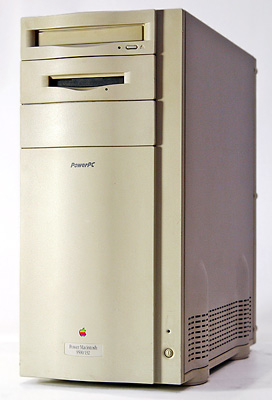2000: This is a story with a sad ending, and I’m not sure that it has any moral, but you may find it interesting. Our tale begins when my son was given the carcass of a Power Mac 9500 – the six-slot minitower that was Apple’s flagship desktop model back in 1996.
 The computer had been stolen from a university computer lab and recovered by the insurance company. It was stripped of its processor card and drives. The insurance company gave it to a friend of my son’s, along with a package of other Mac junk. The friend removed and sold the video card and gave what was left – basically the case, chassis, and motherboard – to Tristan.
The computer had been stolen from a university computer lab and recovered by the insurance company. It was stripped of its processor card and drives. The insurance company gave it to a friend of my son’s, along with a package of other Mac junk. The friend removed and sold the video card and gave what was left – basically the case, chassis, and motherboard – to Tristan.
We thought this machine would make an interesting reclamation project, and set about finding replacements for the missing bits. Low End Mac’s publisher, Dan Knight, had a 180 MHz 604 daughter card and video card from when he upgraded his Umax SuperMac J700 with a G3 daughter card, and he offered them to me on agreeable terms.
Not much happened for several months until Tristan came home for a week at Christmas. His PowerBook had just been stolen, and we figured the 9500 would make a good box to tide him over until the insurance settlement came through.
In went the processor and video cards, the power was turned on, the startup chime chimed, and the hard drive made reassuring bootup noises. But at the point in the boot process where a keystroke was called for, we discovered that the ADB bus was dead. Closer examination revealed a section of the motherboard that had been damaged by the thieves during the stripping operation.
Out came the motherboard, and Tristan attempted to repair it by soldering capacitors across the damaged area jumper fashion. This proved unsuccessful, but it dawned on us that a potential workaround might be to get a USB card and use a USB keyboard and mouse. Tristan took the 9500 with him when he left at New Year’s.
Again, not much happened for several months. The insurance money came through; Tristan bought a new Lombard PowerBook; and the 9500 remained packed in its box until last weekend, when he decided to dig it out and try the USB idea.
He took the machine with him to the Mac dealership where he works part-time and dropped in a USB card. The big Power Mac booted up fine and worked beautifully. Tristan was delighted, especially when a friend gave him a bunch of old DIMMs to fill up the 9500’s eight RAM slots.
He happily took the 9500 home, installed the extra RAM, and powered it up. A strange smell, odd noises, and then fire emerged from inside the case. He quickly pulled the plug and opened the box to discover that one of the RAM modules had burned. There wasn’t enough left of it to determine with any certainty what had gone wrong. Perhaps it was defective or something had shorted.
In any case, it seems that our great 9500 reclamation project had literally crashed and burned. The startup chime still sounds, but the bootup process gets no farther than that. There is likely terminal damage to the motherboard this time. Tristan checked with Mac parts outlet Shreve Systems, and a replacement motherboard would be about $600 – too dear for a shoestring Frankenstein Mac project.
It’s very sad, especially since we finally had the machine working – for about four hours. As I said, there doesn’t seem to be a moral to this story. If you can think of one, let me know.
For more on this subject, see The Frankenstein Power Mac 9500 Letters.
keywords: #powermac9500
short link: https://goo.gl/aBNkjo

